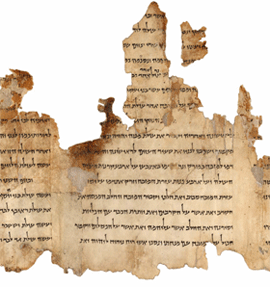|
Fragment from one of the Dead Sea Scrolls
Answer to Name This Famous Antique Game - March 2017
By Mike McLeod

 This fragment from one of the Dead Sea Scrolls found in a cave in Qumran, Israel, is recognizable by just about everyone. Bedouin shepherds initially discovered some of the caves in 1946 and 1947. Of the first seven scrolls brought out was the Isaiah Scroll which measures one inch shy of 25 feet long. It records all 66 chapters of the Book of Isaiah recorded in the Bible, minus some verses lost due to decay and damage. This fragment from one of the Dead Sea Scrolls found in a cave in Qumran, Israel, is recognizable by just about everyone. Bedouin shepherds initially discovered some of the caves in 1946 and 1947. Of the first seven scrolls brought out was the Isaiah Scroll which measures one inch shy of 25 feet long. It records all 66 chapters of the Book of Isaiah recorded in the Bible, minus some verses lost due to decay and damage.
In February, the Hebrew University of Jerusalem reported the finding of a cave that had contained Dead Sea Scrolls at one time but was looted in the mid-20th century. Left in the cave were: storage jars and lids dating to the Second Temple Period (352 BC– 68 AD; the Scrolls date to 300 BC-100 AD); fragments of scroll wrappings; a string used to tie scrolls; and a “…piece of worked leather that was a part of a scroll.”1The University reported this was the first discovery of a scroll cave in 60 years and the twelfth cave used to store them for safekeeping.
To-date, 981 Dead Sea Scrolls have been discovered, most made of parchment and animal skins. However, one was made of copper. It did not contain biblical or scriptural writings but recorded 64 places where gold, silver and scrolls could be found. Part of it have been translated at: “Forty two talents lie under the stairs in the salt pit…. Sixty-five bars of gold lie on the third terrace in the cave of the old Washers House…. Seventy talents of silver are enclosed in wooden vessels that are in the cistern of a burial chamber in Matia's courtyard. Fifteen cubits from the front of the eastern gates, lies a cistern. The ten talents lie in the canal of the cistern…. Six silver bars are located at the sharp edge of the rock which is under the eastern wall in the cistern. The cistern's entrance is under the large paving stone threshold. Dig down four cubits in the northern corner of the pool that is east of Kohlit. There will be twenty two talents of silver coins. (DSS 3Q15, col. II, translation by Hack and Carey.)”2
None of these treasure have ever definitively been found, even though many have searched for it. Some believe these treasures are a myth, just a fairytale. Others ask, who writes a fairytale on a valuable sheet of beaten copper and hides it in a cave? Many think it could be treasures from the Second Temple, or the Temple of Herod, because the records mention tithing vessels and “priestly vestments.” Also, the amount of the treasure is gigantic—4,630 talents of gold and silver. The weight of a talent about 2,000 years ago isn’t known exactly, and amounts vary from 75 lbs. to 130 lbs. On the low end,4,630 talents would equal 347,250 lbs. of gold and silver—worth a billion dollars or more.3
The copper scroll was found rolled up, oxidized and broken into two pieces. Its brittleness made it impossible to unroll. In 1955, it was cut lengthwise into 23 pieces which were eventually put back together in a readable form.4
Ted Carlton of Utah correctly identified the Dead Sea Scrolls.
--------------------------------------------------
Credits: Ancient-origins.net and Unmuseum.org.
Photo public domain, PD-US.
1 New.huji.ac.il, “Hebrew University Archaeologists Find 12th Dead Sea Scrolls Cave,” Feb. 8, 2017.
2, 3, 4 Ancient-origins.net, “The Lost Treasure of the Copper Scroll, by April Holloway, March 18, 2014.
|